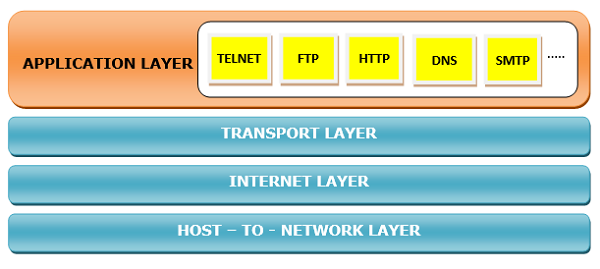
 Data Structure
Data Structure Networking
Networking RDBMS
RDBMS Operating System
Operating System Java
Java MS Excel
MS Excel iOS
iOS HTML
HTML CSS
CSS Android
Android Python
Python C Programming
C Programming C++
C++ C#
C# MongoDB
MongoDB MySQL
MySQL Javascript
Javascript PHP
PHP
- Selected Reading
- UPSC IAS Exams Notes
- Developer's Best Practices
- Questions and Answers
- Effective Resume Writing
- HR Interview Questions
- Computer Glossary
- Who is Who
The Application Layer in TCP/IP Model
The application layer is the highest abstraction layer of the TCP/IP model that provides the interfaces and protocols needed by the users. It combines the functionalities of the session layer, the presentation layer and the application layer of the OSI model.
The functions of the application layer are −
- It facilitates the user to use the services of the network.
- It is used to develop network-based applications.
- It provides user services like user login, naming network devices, formatting messages, and e-mails, transfer of files etc.
- It is also concerned with error handling and recovery of the message as a whole.
This layer uses a number of protocols, the main among which are as follows −
- Hyper Text Transfer Protocol, HTTP − It is the underlying protocol for world wide web. It defines how hypermedia messages are formatted and transmitted.
- File Transfer Protocol, FTP − It is a client-server based protocol for transfer of files between client and server over the network.
- Simple Mail Transfer Protocol, SMTP − It lays down the rules and semantics for sending and receiving electronic mails (e-mails).
- Domain Name System, DNS − It is a naming system for devices in networks. It provides services for translating domain names to IP addresses.
- TELNET − It provides bi-directional text-oriented services for remote login to the hosts over the network.
- Simple Network Management Protocol, SNMP − It is for managing, monitoring the network and for organizing information about the networked devices.
The following diagram shows the transport layer in the TCP/IP protocol suite −


Advertisements
